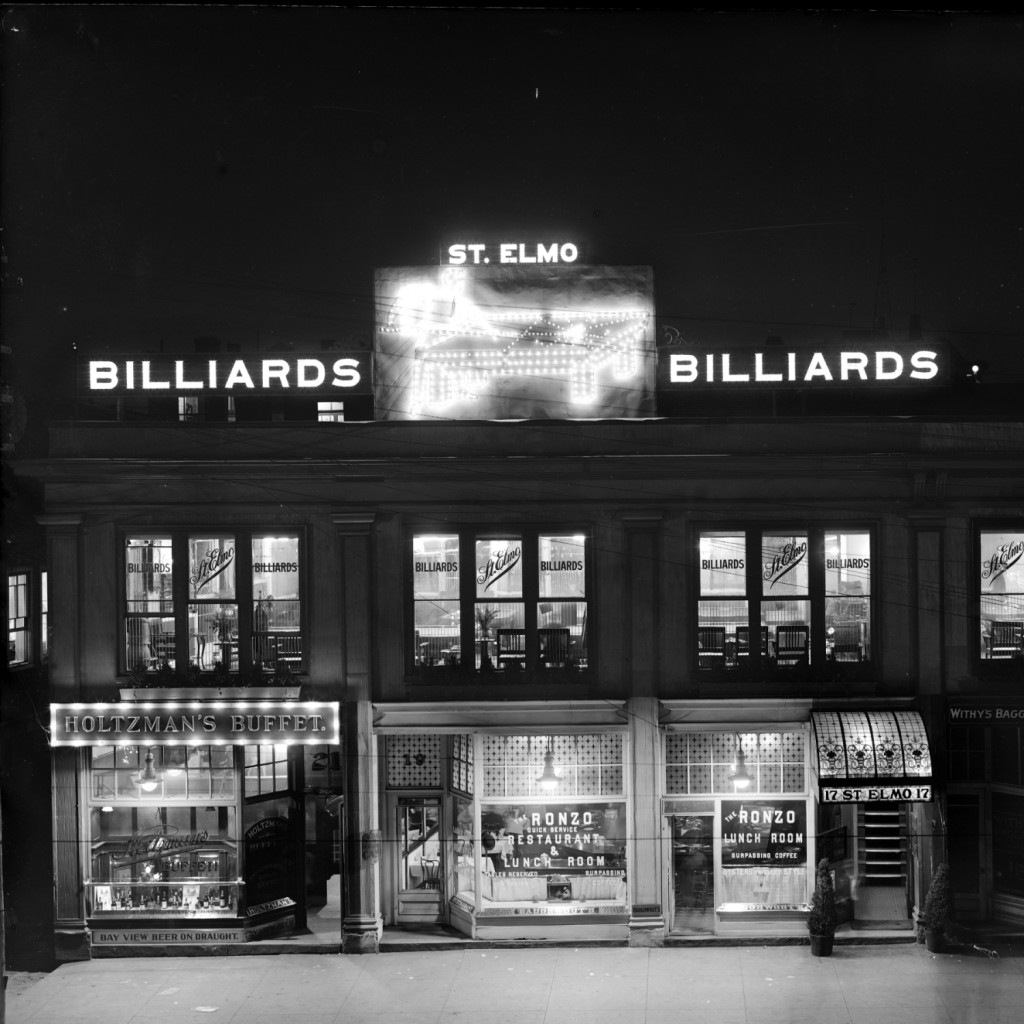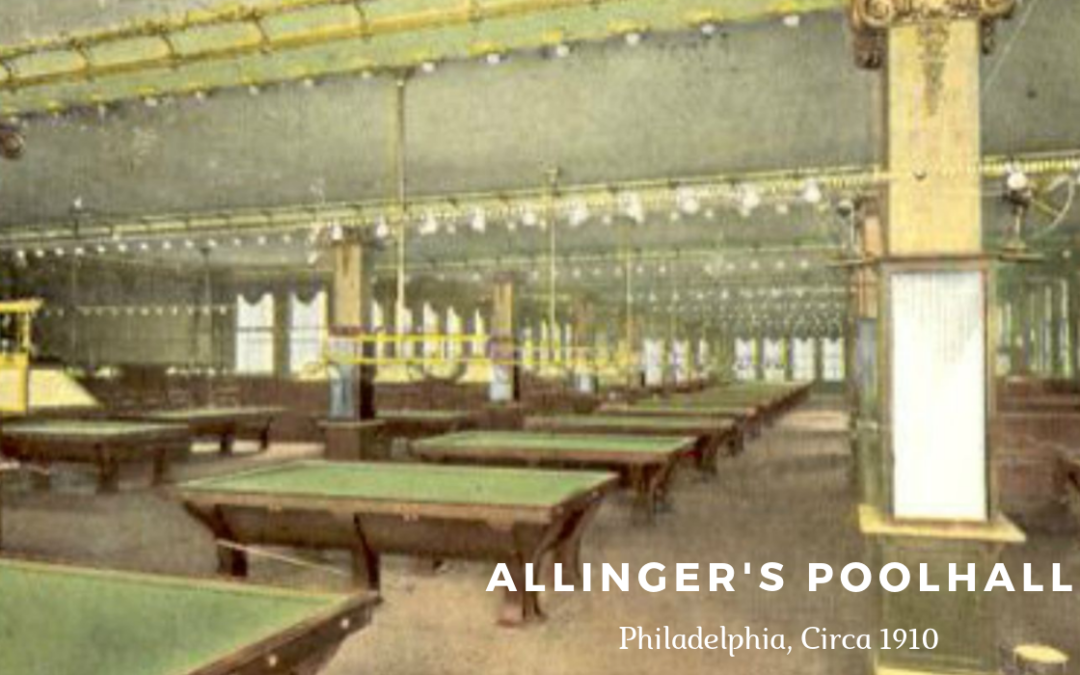Pool halls. Everyone has a favorite. I was partial myself to Houston’s Cue & Cushion and Costa Rica’s Center Pool. Both now are defunct. For this post I’ve reproduced a number of letters I’ve received over the years about our readers’ favorite rooms. Some were stately. Others decrepit. But all, in their way, important.
At the end of this post I’ve also included my own short essay about the Cue & Cushion poolroom in Houston. The essay appeared some years back in the daily newspaper there, shortly after that poolroom closed. And finally: here’s a link to a Billiards Digest column about Fort Worth’s Fast Freddy’s. It’s said to be haunted. And here’s a second link to a post on poolhistory.com pertaining to New York’s now shuttered Julian’s pool hall. There’s also photos on that post.
Now, on to the letters!

St. Elmos, Norfolk, Virginia, Ken McCarthy
“When I was in the navy (1961-1965) I was stationed in Norfolk ,VA and played pool every minute I had at St. Elmos pool hall (2nd floor, a few buildings up from the YMCA). As you know this is where Wimpy played when in town, and it is where I saw him ( I still have a perfect vision of that white head standing out in the dimness along the left wall watching the goings-on). I was just starting to play pool and my friend pointed him out to me as a great player, although at the time I really didn’t realize HOW great a player.
“In 1963 or 64 I bought a Willie Hoppe special (Brunswick) cue through the owner (a kindly, short, bald-headed man). I then sanded off a section on the top of the butt, bought a Parker ink pen and asked Mr. Lassiter to sign it. He did, and I still have the cue and the pen. I have recently picked up the game again and I now know that he was actually at the top of his game when he signed my cue!”
Allinger’s, Philadelphia, Michael McCafferty
“I remember Allingers! I played there a few times in the late ’50s, early ’60s, when I was still in school. It was on the second floor, but since whatever was on the first floor had really high ceilings, the climb up the stairs to Allinger’s was long and narrow, and it wasn’t unusual to pass a few bums hiding out from the weather.
Inside, right in front of the counter, was the main action table, with a prominent sign proclaiming ‘NO GAMBLING’, but of course that was just for show.
The floors were all bare wood planks, and I remember that the place wasn’t a high example of cleanliness, but there seemed to be a high degree of orderliness.
The strongest memory I have of Allinger’s was the rack girls. You could rack your own, of course, but if you could also get help. Bang your stick on the floor a couple of times, yell ‘RACK!’ and a little black girl would scurry over and rack ’em for you, for tips. I remember the going rate was a dime a rack, pretty good money in those days.
Allinger’s was a Philly landmark, the high holy place of pool south of New York City.
When I graduated from college and started working for a living, pool left my life for 40 years, during which time Allinger’s quietly closed up forever.”
Allingers, Philadelphia, Rayna Polksy
“My Grandfather, Sam Ross, owned Allinger’s probably from about 1945 until it closed. The business was managed by Sam Ross and his family: Martin Ross, Louis Ross, Jerry Ross, Jay Ross and my father, Irving Polsky. In addition to helping to manage the place , my father did most of the repairs and maintenance of the billiard tables. In addition he made cue sticks. Many of the famous players came to Allinger’s: Willie Hoppe and Willie Mosconi for example. My dad would bring me to Allinger’s on the weekends and teach me how to shoot pocket billiards. Unfortunately, I never had much talent for playing pool.”
Texas Recreation, Fort Worth,Texas, Big Daddy
“When I was a teen-ager in Fort Worth, I had an uncle who introduced me to Texas Recreation in downtown Fort Worth. This was an open-bay pool room with dozens of tables where you played for 60 cents an hour. I came back later when I was 16 and 17 and hustled pool there. Ask around, old timers probably remember the pool hall.
It was located in downtown Fort Worth on Houston Street on the second floor over a burlesque house. The burlesque place had photos of dancers in glass frames on the walls in front of the place. These were girls with feather boas wrapped around their waists and chests. I never went upstairs before checking out the photos of the dancers that week. Right next door to the burlesque house was Peters Bros. Hat stores, which has been fitting cowboy hats since 1933 at the same location. It is still there.”
Cue & Cushion, Houston, Texas, R.A. Dyer
“It was a great pool hall, having been a favorite haunt of Jersey Red, John “Duke” Dowell, Texas Bob and a cast of colorful others. I remember watching when guys like Corey Deuel and Jeremy Jones strolled in, looking to make games. Both are former U.S. Open 9-ball winners. There have been plenty of others, too — even world-class players from overseas — and so it was always wise to know who was who and what was what when you were invited to play for money at the Cue & Cushion.
Such big-time players always drew spectators — the railbirds, they called them — and these railbirds would crowd around the end of the tables, sometimes balancing on their heels to afford themselves a better view of the action. The out-of-town professionals would match up with the local hotshots, and the local hotshots would ask for a “spot,” or handicap, to make the games more even.
When you asked for a table at the Cue & Cushion the bartender would mentally size you up and then you’d be sent off to play on one side of the L-shaped room or the other. The regulars would invariably go to the tables on the south side, while the casual players would go to the west.
It was there where I first met the great Jersey Red, remembered today as one of the greatest one-pocket players in history. Red could give away giant, ridiculous handicaps at this variation of pool (in one-pocket, you must sink all your balls into a single pocket) and still come away with the cash. Before his death of cancer in 1998, Red was a fixture at the Cue & Cushion. It was also at the Cue & Cushion where I picked up stories about other legends — of men like Greg “Big Train” Stephens, for instance, who once ran 11 racks consecutively playing nine-ball against Wimpy Lassiter, or of the great Willie Mosconi, who could run 60 and 70 balls as easily as us mere mortals would run three or four. The old-timers at the Cue & Cushion were actually eyewitnesses to these events. For the price of a beer, they’d eagerly regale you with these stories and more.
With its demise, Houston has lost a small connection with its colorful past.”

My father played at Allengers in Philly a lot in the early days. He won the 1950 Philadelphia Championship at Allengers. He played against some of the greats: Mosconi, Greensleaf, etc. Later he opened a poolroom at Allegheny and Lee street with a partner. It was called Circle Billards. During those early years, both Frankie Avalon and Jack Klugman racked balls.
In his senior years he hung at two northeast Philly poolrooms (I forget the names) and taught younger people how to play. I remember him telling me he charged $5 and hour (1970s).
Harry Hallman was a wonderful person and a very good player. I met Harry in the late 60’s as a 14yr old kid at boulevard billiards in NE Phila and he was like a grandfather to me. We were friends. Harry never charged me a dime for pool tips but I learned a lot from him. I think Harry was a sheet metal worker at some point. For some reason I don’t remember the cue he used but he had a real nice hard brown leather case.
I played pool many years ago at City Billiards in Elizabeth City, NC. I always loved when Wimpy was back in town and would start practicing before he was going to play in a tournament. He used to run rack after rack playing straight pool and would glide around the table dropping one ball after another with such precision. I’ve heard they’re going to put a historical marker at his home on Pearl Street. I’ll be sure and check it out the next time I’m out that way.
We have a Cue & Cushion in St Louis Mo. Still a great place to buy or shoot a game of pool.
I can 2nd that C&C Comment, We also in Afton(stl suburb) had The Sports Center where at any given time before his all to young death you could watch the great St Louie Louie Roberts run rack after rack like he was a machine built to do that exact thing it was beautiful,
There’s also a small place about 60 miles south of St Louis in Farmington, Mo called Cuzzins Sports Bar only 5 bar boxes but yet a regular road stop for players for the constant action you never know who you where able to walk in and see, Roberts,Buddy “the rifleman Hall, Tony Fargo or Bar box master Dave Matlock I was lucky enough to grow up here ,and wouldn’t change a thing ,Thanks Guys
I cut my teeth at Cue in StL. The owner, Shirley Huddleston just passed. I fear for the future of the place.
That nice Bald headed guy at St Elmo’s was probably Charlie.
I have got lucky and got one of the old brunswick pfister pool tables that was in allingers years ago.
It is a 5×10 six leg table from the 2nd floor. I’M sure it has a lot of history.